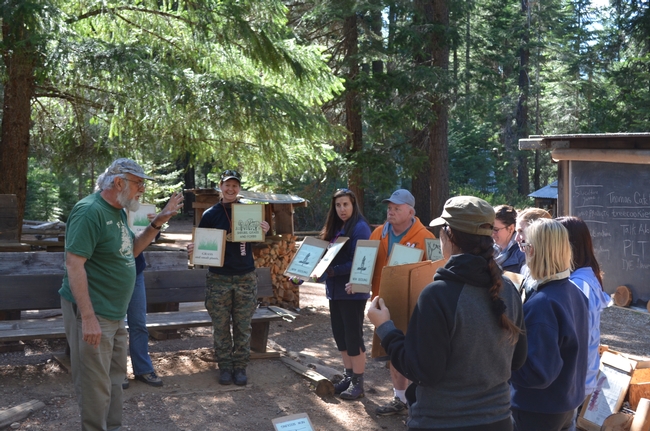California teachers are invited to spend a week in a northern California forest this summer and participate in the Forestry Institute for Teachers.
“The goal of the Forestry Institute for Teachers, or FIT, is to provide K-12 teachers with knowledge, skills and tools to teach their students about forest ecology and forest resource management practices and introduce them to environmental education curriculum such as Project Learning Tree, Project WILD and California's Education and the Environment,” said Mike De Lasaux, UC Agriculture and Natural Resources Cooperative Extension advisor for Plumas and Sierra counties and a FIT instructor.
The program, which is in its 23rd year, brings teachers from rural and urban settings together with natural resources experts to gain a deeper understanding of the relationship between forest ecosystems and human use of natural resources. The environment becomes the basis for learning in many subject areas, including environmental science, physical science, social science, biology, forestry and history.
“FIT gave me a lot of physical group activities and ideas for how to get to know a new group of people,” said Renata Martin, who is a substitute teacher for grades 3 through 8 in the San Francisco Bay Area.
By examining the rings in a tree's cross-section, foresters can tell a lot about events – such as wet or dry periods, insect or disease damage – that have occurred during the tree's lifetime. She has used the tree analogy to teach students that important events shape their own lives.
“Especially because I meet new kids every day, I've been able to use the lesson that we did around the campfire the first night with sharing important points in our lives as if they were tree cookies” or slices of a tree, said Martin.
FIT emphasizes California Department of Education Content Standards including Common Core and Next Generation Science Standards. Since 1993, more than 2,200 teachers have graduated from the program.
Using what they learn at the workshop, the participants conduct training for their colleagues and develop a forestry education project for their students during the school year.
Martin, who participated in FIT in 2014 in Plumas County, said she has adapted many of the lessons for her students based on their age, development and behavior.

Meeting forest-related professionals including small property owners, archaeologists, large lumber corporations and historians made an impression on environmental educator Carrie Raleigh. “It was interesting to get a variety of perspectives on forestry issues and to have face-to-face conversations with a variety of specialists,” said Rawleigh, who participated in the program in 2010 and teaches in Riverside and San Bernardino counties.
Four 1-week FIT sessions are scheduled at four different locations: Plumas, Tuolumne, Shasta and Humboldt counties.
Two June sessions will be held at the University of California Forestry Camp, close to Quincy in Plumas County, and at Sierra Outdoor School near Sonora in Tuolumne County. The July sessions will be at Camp McCumber just east of Shingletown in Shasta County and at Humboldt State University in Arcata in Humboldt County.
The presenters and staff include public and private forest resource specialists and other natural resource managers, environmental activists and science and environmental education curriculum specialists. Groups are welcome to register as teams. There is an application fee of $25, but training, meals and lodging are free for first-time participants.
The deadline for applications is March 16. For more information and to apply, visit http://forestryinstitute.org or call the Forest Stewardship Helpline at (800) 783-8733.
The Forestry Institute for Teachers (FIT) workshop was developed by the Northern California Society of American Foresters, University of California Agriculture and Natural Resources Cooperative Extension, Shasta County Office of Education, The California Department of Forestry and Fire Protection, and Project Learning Tree. The FIT Program is underwritten by a consortium of public and private sources.
An initiative to maintain and enhance sustainable natural ecosystems is part of UC Agriculture and Natural Resources Strategic Vision 2025.
